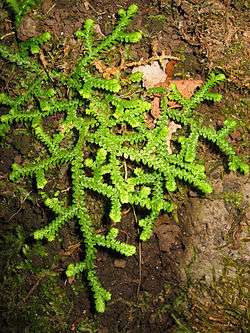Selaginella denticulata
| Selaginella denticulata | |
|---|---|
 | |
| Scientific classification | |
| Kingdom: | Plantae |
| Division: | Lycopodiophyta |
| Class: | Isoetopsida |
| Order: | Selaginellales |
| Family: | Selaginellaceae |
| Genus: | Selaginella |
| Species: | S. denticulata |
| Binomial name | |
| Selaginella denticulata (L.) Spring | |
Selaginella denticulata or Mediterranean clubmoss[1] is a non-flowering plant of the spikemoss genus Selaginella with a wide distribution around the Northern Hemisphere. Selaginella denticulata (L.) Spring., Formerly known as Lycopodium denticulatum L. and treintanudos is the common name in the Canaries.
Description
It is in the genus Selaginella and this creeper is characterized by having flattened stems, bearing four rows of ovate leaves which vary in size according to their position. Its specific epithet, "denticulata" comes from the Latin "dens" which means tooth, and alludes to the denticles that appear on the leaves. It was identified by the nineteenth century botanist Antoine Frédéric Spring.
It is distributed throughout the Mediterranean region except for the Cape Verde islands. It is not under threat although it is less common in the Eastern Mediterranean.[2] It prefers dark cave environments and it is found on Gibraltar,[1] throughout the Mediterranean region and in Portugal. In the spring it is green but as it dries out the plant is red.[3]
References
- 1 2 Gibraltar Flora, GONHS.org, accessed August 2012
- ↑ Selaginella denticulata, IUCN Red List, accessed August 2012
- ↑ Complete Mediterranean Wildlife: Photoguide Harper Collins, accessed August 2012
| Wikimedia Commons has media related to Selaginella denticulata. |
| Wikispecies has information related to: Selaginella denticulata |